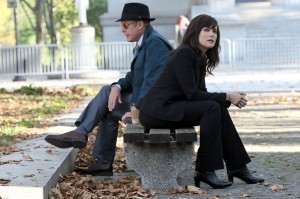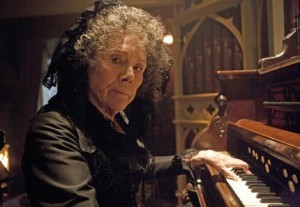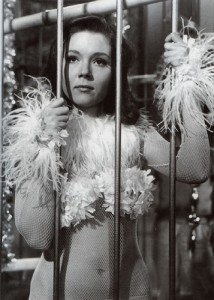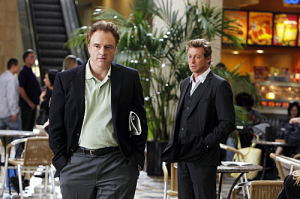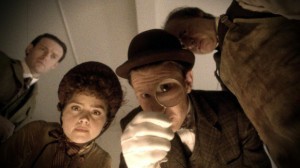Jennifer Crusie's Blog, page 283
December 5, 2013
Don’t Nobody Bring Me No Bad Reviews
The new editor of Buzzfeed has just announced that .
Huh.
I don’t actually care what Buzzfeed does, I’m just puzzled by this approach. The editor, Isaac Fitzgerald, says it’s based on the Bambi rule, first articulated by Thumper: “If you can’t say something nice, don’t say nothing at all.” (I know it’s a double negative; Disney rabbit children have NO grammar skills.) That’s a good rule in a specific situation: if you’re chatting socially, be kind or at least polite. What the hell that has to do with book reviews is a puzzle.
A book review, as I understand it, is a report from a reader evaluating the book. The quality of the review depends not only on the quality of the reviewer–understanding of craft, writing ability, etc.–but also on the mindset of the reviewer. A reviewer who takes her work seriously can produce a review that says a book is bad and then back it up with concrete, specific, intelligent reasons why that is so; that bad review is a good review. I think the kind of bad review Fitzgerald is talking about is the bad bad review, the reviews motivated by spite, the ones dripping with self-satisfied bile, the ones based on ignorance (like the PW reviewer who reviewed our collaborative novel, The Unfortunate Miss Fortunes, and said, “This would have been better if it had been a novel”). There are too many reviews out there written because the reviewer wanted to show off how cool he was, sneering down at the fiction in order to elevate himself (or herself). Those reviews are toxic, no good for anyone including the reviewer who is spitting acid on his karma. I can see why an editor wouldn’t want that kind of thing on a site he was proud of.
But the “let’s be nice” approach is death to real understanding, I think. All reviews are subjective, but the ones that carefully examine a book and explain the basis for reviewer’s bad opinion can be informative, even educational. (I like reading the one star reviews on Amazon because they not only reveal things about the books, they reveal things about the reviewers; the woman who writes, “This is a terrible book; the author uses bad language and the heroine is a slut,” makes me not only visualize the reviewer as the Church Lady, it makes me want to read the book.) I’ve learned a lot from reviewers who didn’t like my books and told me why; they’ve pointed out weaknesses in my writing and blind spots in my world view. I don’t want those reviewers hobbled; I need them to get better.
But mostly readers need bad reviews, or more to the point, honest reviews. So I think this is a big mistake on Fitzgerald’s part. I think it’s entirely within an editor’s right to say, “Your reviews must be cogent, civil, and well-argued,” but not to say, “Your review must be positive.” Huge difference there.
So now I’m curious. How do you use reviews? Would this approach work for you? That is, do you use reviews to decide what books to read, so an all-good review system would just focus in on the stuff to buy? Or do you need more than a thumbs up when it comes to reviews?

December 4, 2013
A Short Rant About Set-Ups
You know, I try to be open-minded about writing, I really do. I do believe that each story is different, that no rule always applies, that rules should be tools not strait jackets, that . . .
The hell with that. SET-UP IS NOT STORY. I swear to god the next film/TV show I see or book I read where there’s a ton of lifeless crap at the beginning because the writer needs to set stuff up will be the last show or book by that writer I will invest my time and money in. I know it’s easier to write story if you can say to the reader/viewer, “I have a great story to tell you but first, I need to set it up, give you some background, let the character ponder his or her situation, and introduce characters that will be important later without giving them a reason for being on the page now, so just bear with me and remember all of this stuff because I’m going to use it later in the story.” You know what? Making things easier on yourself as a writer while making things harder on the reader/viewer is just lazy, crappy storytelling, no excuses. Start with the story, with the protagonist in conflict and then keep going. Nobody put a gun to your head and said, “You must make things up.” You volunteered for this gig, you’re taking time and money away from people in exchange for your story, get off your ass and TELL THE DAMN STORY.
There. Rant over.
Okay, maybe not. I still need to talk about it. I just watched this week’s The Mentalist. This was supposed to be the big revitalizing episode, the one that happens two years after Jane strangles Red John, everything different, the new story after the turning point. Exciting, right?. Except the show is still moving at a pace a snail would sneer at. They spent the first THIRTEEN MINUTES on set-up that included a Mean Drug Dealer and a Mysterious Women, a set-up that pretty much laid out the next thirty minutes of our hero leisurely paying back the drug dealer (but only after he killed a dog) and dancing with the woman who of course turned out to be an FBI agent looking for him (did ANYBODY not see that coming?), ending in last two minutes that basically said, “Never mind all of that, that was all just set-up for the reboot, we’ll tell you about the new direction the show’s going next week.” Well, no, you won’t. I’m out.
You know who the writers of The Mentalist should talk to? The writers of The Blacklist.
At the start of the season, the premise of The Blacklist left me cold (an internationally known terrorist makes a deal with the FBI to supply info about the people on their most wanted list as long as they make a newbie FBI agent work with him), plus it had a twinkie (Megan Boone) as the newbie, and I was already twinkie-poisoned by Skye on SHIELD, so I wouldn’t have watched the pilot except that it stars James Spader and James Spader does good work. The start of the pilot was pretty good, it hit the ground running and told a good story while setting up the season to follow, although it was obvious that Spader’s character (Red) was Boone’s character’s (Lizzie’s) father and they were going to milk that for the entire season (everybody saw that coming) and . . . oh, wait a minute. Maybe he’s not. Okay, but Lizzie has this crunchy-granola perfect husband and they’re going to adopt a baby and her marriage is so sweet, it’s cloying and . . . oh, wait a minute. Maybe Crunchy Granola is evil. And then there’s Red himself, a snarky terrorist with a heart of gold, and . . . sweet Jesus, did he just do what I think he did? Heart of gold, my ass; this son-of-a-bitch has no boundaries.
So I kept watching. I had to. Those writers would do anything.
And then every damn episode hit the ground running and twisted and turned, with Red looking dour except when he smiled which was when things really got terrifying. And Lizzie, well, she was a fast learner and she wasn’t taking any crap from Red, so there were no tearful, heartwarming are-you-my-daddy moments. Plus there was all this other stuff, like her I’m-pretty-sure-he’s-evil husband, and the Ken doll FBI agent who sneers at everybody is actually not a Ken doll, and Red’s bodyguard Dembe has real dimension, so I stuck with the Criminal of the Week stories and kept getting gobsmacked every week. That Red, he’ll do anything. And then this week, they earned my undying admiration by blowing it all up. The deal’s off, Alan Alda is a torturing son-of-a-bitch, there’s a mole in the FBI, the Ken doll is flirting with his engaged ex, I really do not trust Lizzie’s tree-hugger, secret-keeping husband, and Red is in the wind. It took The Mentalist five and a half years to do what The Blacklist did in ten episodes. I am so impressed. And you know what a jaded bitch I am about story.
Here’s something I love. The Blacklist’s titles are all the names and numbers of the people on the list: “The Courier, No. 85,” “Frederick Barnes, No. 47.” But when the show comes back January 13, the episode is titled, “The Good Samaritan Killer.” The Mentalist did five and a half years of titles with red references; Blacklist writers set up numbered titles and then turned left with episode eleven. I LOVE THESE GUYS. They take such delight in overturning expectation, and that makes for great story because one of the keys to great storytelling is fulfilling expectation while surprising the reader. If all you do is fulfill expectation, you bore the reader. If you come completely out of left field, the reader says, “WTF?” and leaves for a story that makes sense. If you can surprise the reader and still have her say, “OF COURSE that’s what happened, why didn’t I see it?” you’ve grabbed the storyteller’s gold ring. The Blacklist writers must own a jewelry store by now.
I think abusing set-up (and it’s older, dumber cousin, slow story-telling) comes down to one fatal flaw: underestimating the reader/viewer. I think you have to assume that your reader is smarter than you are. The minute you start spoonfeeding back story, over-explaining and over-simplifying, you’ve dumbed your story down, slowed it to a crawl, and drained the life from it. I remember one of my writing teachers once saying, “Don’t ever save anything for the next story. Put it all in the story you’re writing, everything you can.” I think he was right. I think you have to trust that your reader is not only smart but that she wants to be challenged, thrilled, delighted, that there’s something exciting on every page, in every scene, that she’s always a little off guard, that she loves those turning points that make her go “Whoa!” and recast what she thinks about the story and then read on with renewed excitement. I think the minute you think “I have to write this part to set up the story,” your story is screwed because you’re not thinking, “I have to write this part because it’s SO DAMN GOOD AND SO MUCH HAPPENS AND THE READER IS GOING TO LOVE IT.”
I was afraid that The Blacklist might get cancelled because it’s so different, its hero is such a bastard, and it turns its story so swiftly and so ruthlessly, but it turns out the writers were smart not to underestimate their audience. It’s the most watched drama on NBC in twenty years and the number one new show on the Big Four networks. And it’s just been renewed–after ten episodes–for another year.
Slow set-up kills, smart story sells, and you really should be watching The Blacklist, although be prepared for an anti-hero; that Red is a real son-of-a-bitch.

December 2, 2013
Next Who Sunday: The Name of the Doctor, Steven Moffat
I have to admit, I was completely confused about pretty much everything in this episode except the Doctor’s farewell kiss to River. Moffat’s Doctor-centric mythology got so tangled by the time we got here, that I was always pretty much always lost throughout the season (although I loved the tour of the Tardis in “Journey to the Center of the Tardis”) and I still don’t know what happened in this one. The Doctor visited his own grave, River did an inter-dimensional conference call, Clara fell through all the timelines rescuing all the Doctors which I found annoying, The Great Intelligence killed itself (I think), John Hurt showed up as a Doctor but not one of the The Doctors (huh? never mind, I saw the anniversary special, but now I have no idea what number of Doctor we’re on), and then the Doctor went into his own time stream . . . Look, it’s the season finale and it sets up the Christmas story where Matt Smith turns into Peter Capaldi, so we’re watching it, but I don’t know WTF is going on. Except for the Doctor kissing River, that was excellent, although I still don’t understand if that’s it for River, except she died back there with Ten, so shouldn’t she still be hanging out with Twelve since her timeline is backwards?
My head hurts.

December 1, 2013
Who Sunday: The Crimson Horror, Mark Gatiss
As a big Diana Rigg fan, I love her performance in this. She’s never been afraid of over-the-top characters (remember Emma Peel in the feather outfit in the birdcage?) so she really bites into Mrs. Gillyflower with a complete absence of vanity and sanity. There’s something about evil that is complacent in its confidence that’s more chilling than rampaging demons. Mrs. Gillyflower is completely round the bend, but she’s good with that, thanks.
ETA:
So I went back and watched this again, specifically to see why I liked it so much, and yep, there are big weaknesses in this, especially that sepia-toned flashback that Katie commented on. Here are my notes:
Great opening: sets up everything in 57 seconds: a man tells a woman he’s going to “get to the bottom of this business and goes through a door, Mrs. Gillyflower shows up immediately to comfort the woman on the death of her husband, the woman says, “But my husband is alive,” there’s a horrendous scream, and Mrs. G repeats “We’re so sorry for your loss.” Diana Rigg is amazing as always. They get the major set-up done in the first 10%, the titles are fast, it’s all wonderful until minute 17 when they do a five minute flashback that’s just annoying, even more annoying because the beginning was so strong, the mood–tongue-in-cheek steampunk horror–is so well set, the characters are so compelling. Then they infodump for five freaking minutes. If you ever needed a clear example of why flashback and infodump are bad, this is it.
Then there are the repeating elements: Diana Rigg as the Worst Mother Ever crossed with Crazy Bitch in Control, Rachel Stirling as the extremely creepy blind girl who calls the Doctor “my monster,” the Paternoster Gang in full strength. Unfortunately Clara is another repeating element with people continually asking how it’s possible she’s not dead after fell out of the sky. It’s the Doctor, use your imaginations. Also, I don’t CARE about Clara, she’s the most annoying thing in this episode because the last thing real snarky steampunk horror needs is a manic pixie impossible girl who keeps widening her eyes to telegraph how cute she is. Also annoying: the way the Doctor treats the Paternoster Gang. He kisses Jenny, knowing full well she’s married to Madame Vastra and when somebody asks about Vastra, he says, “She’s a lizard.” No, she’s not, and you’re a jerk in this one, Doctor.
But there’s a great steampunk machine of destruction ready to rain prehistoric red leech juice on England (really, how can you not like that as a threat?) and the big disgusting reveal of who Mr. Sweet really is, which Rigg practically rolls in, and good for her. She’s fabulous in this, ending in Mr. Sweet meeting Ada. Really, that’s a great pay-off. And then they step on the great climax by nattering on about Clara and setting up the next episode which is just weak writing.
So I still think this is worth watching, so over the top and such good stuff, but flawed? Dear god, yes.
What do you think?

November 30, 2013
Cherry Saturday: 11 30 2013
Today is Stay at Home Because You Are Well Day, an idea that is wasted for school children everywhere by being on a Saturday.

November 29, 2013
NOW It’s the Holidays
As an American, I feel strongly that it’s not the [Put-However-You-Celebrate-the-Winter-Solstice-here] season until I’m eating leftover turkey. This insane rush to start hauling out the holly before we’ve finished the pumpkin pie is just wrong. Which is why I could not post this traditional Argh Christmas video until today. (I know we put it up every year. It’s TRADITION. Also I love it.) Happy holidays, whatever holiday you’re celebrating, because the Drifters are Men for All Seasons.

November 28, 2013
Happy Thanksgiving, Argh People
I realize that not all Arghs celebrate Thanksgiving, but I’m still grateful to all of you; you make this a better place with every comment you leave. So today, I’m thankful for the Argh People. And for gravy. In that order, which considering how much I love gravy is saying something. Here’s hoping you have a wonderful holiday season wherever you and whatever you celebrate. As my mother would say, I just want you to be happy.

November 27, 2013
I Want To Be What She’s Wearing
Romance fiction sometimes gets a bad rap because we like to focus on clothes and shoes, and that’s not serious stuff. But I think that ignores a truth about people, and not just female people: we tend to invest meaning in special pieces of wearables, things that we wore at crucial times in our lives. I have a closetful of clothes I bought because I was sure if I wore That Thing, something magical would happen. Sometimes it did, and That Thing was a little bit magic after that; it soaked up the magic in the moment and became more than a dress or a shirt. Sometimes it becomes the Lucky Shirt that you always wear to take the big tests, run the big races. Sometimes it becomes armor against the world, the dress you wear that you know never fails. Cinderella isn’t the only one who’s transformed by a great dress; we walk taller when we know we’re looking good, smile wider; the classic makeover scene transforms more than the way the heroine looks, it changes who she is. Our clothes say so much about who we are and how we navigate the world that it’s not surprising that they figure in our fantasies, too.
I think that’s why so many great female characters come with or come to own great wardrobes. Not expensive wardrobes, not designer wardrobes, they just wear clothes that say, “This is who I am,” and those clothes make us like who they are even more, for the space of the story want to be them. For example:
I want to wear a black shirt and a leather jacket and try to understand what the hell Charlie Crews is talking about.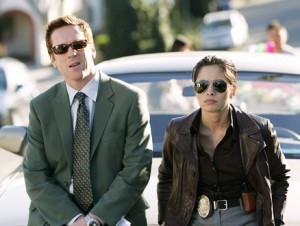
I want to wear mitered stripes and battle wits with Walter Burns (I think I crave the miters more than Walter, but it’s a close call).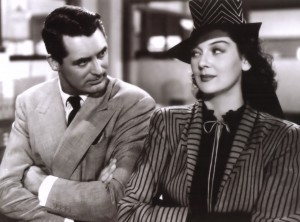
I want to wear a worn leather jacket that fits me like a second skin and explain the 21st century to Ichabod Crane: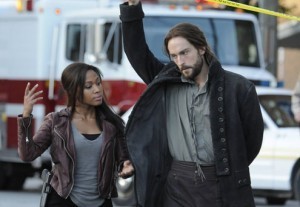
I want to wear a hat with a checked brim and tell Sam Tyler to stay. Forever.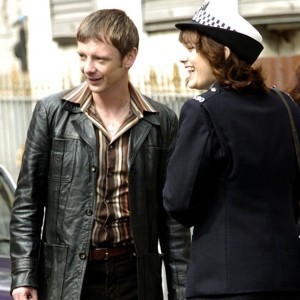
I want to wear sharp black separates and fist bump with John Reese: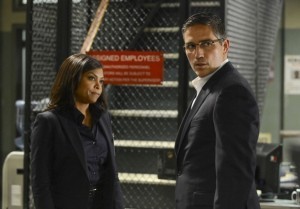
I want to wear pink sunglasses, a black leather jacket, and a poofy pink skirt on a motorcycle behind the Doctor.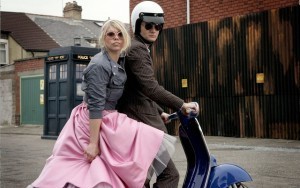
Okay, clearly there’s a leather jacket in my future. What fictional character–book, TV, movie, graphic novel, whatever–made you say, “That. That’s what I want to be for awhile.” And why?

November 26, 2013
Time and the OMG Moment
It’s hard to grasp the concept of turning points, especially when you’re writing them. They’re places in a narrative where the entire story turns in a new direction, where the character crosses a boundary he or she had never crossed before and can never return from. They can be small events or big ones, but they have to be events. We tend to see turning points as the impact they have on the character or the story instead of the event itself. But “This is when Andie realizes there are ghosts” is not a turning point. “Andie has a terrified conversation with ghosts” is a turning point. It’s a thing that happens, not an outcome. The impact of the turning point depends a lot on the outcome, but an additional factor in that impact is the timing of that turning point. If you spread turning points too far out, if a reader or a viewer has to wait too long to get that Oh-My-God moment that makes everything new, she’s just not going to care. Two TV shows had OMG moments in the past week, but only one of them pulled it off, and it was all because of timing.
SPOILER NOTE: If you didn’t see Person of Interest or The Mentalist this week, there are major, crucial spoilers below.
We’ve already talked about PoI‘s OMG moment: the death of a major and much-loved character at her moment of greatest triumph, two and half years after she was introduced. Joss Carter’s struggles with the corrupt police organization HR which had begun in the first season had escalated until she was driven by vengeance and righteous outrage to cross lines in this third season that she would never have crossed in the first. And she was so well written (and brilliantly acted) that when she crossed those lines–she shot people to death, she rescued a mob boss and stashed him in a safe house, she turned a corrupt cop into a lackey instead of turning him in (there’s a precedent for that in this show)–we were with her completely; she worked outside the law because the inside was rotten, and she brought all the bad guys down. She was magnificent, and then she died protecting somebody she loved, much too soon.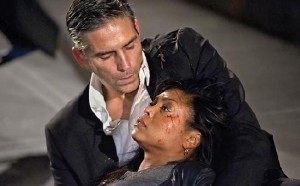
We weren’t ready to let go of Carter, there was too much we wanted to see her do. Much of the critical outcry–io9′s headline was “NO NO NO! ALL THE NO!”–was also critical appreciation: it was a brilliant decision on the part of the writers because the show needed a turning point. Carter had been chasing HR for three years; it was time that chase ended. But if it ended with Carter striding off into the sunset, victorious, there was nothing left for her to do; she’d achieved her story arc. More than that, that resolution wouldn’t do anything for the story itself. Instead Carter’s death makes everything new; nobody in that tight group of savior-complexes is going to come away from not saving the person they loved most without massive emotional damage. The turning point is Carter’s death; the impact is the rest of the season, reverberating for the rest of the series. I hate it that Carter’s gone, but I cannot wait to see what happens next. That’s a great turning point.
And then there’s The Mentalist. The main strength of this show is its cast, not just the CBI team but the supporting players that have gone kicking and screaming through its plots. The writing ranges from great to abysmal, but the cast stays solid, and that has kept me watching even though there have been any number of times I thought, “Why am I still watching this?” The problem here is that the people in charge know they have a hit on their hands, and they’re determined not to make any big changes so that the show will keep running. “People like this, let’s not risk changing it.” That way lies story death. The premise–that former con man Patrick Jane is on a vendetta to find the serial killer, Red John, who butchered his wife and daughter–was a strong one in the beginning, and there were stories that were riveting. One of them was the climax of the third season when Jane finally met Red John in a mall, sat down at a table and talked to him. Red John turned out to be everything a story-hungry viewer could have hoped for: charming, cruel, confident, and completely in control (Bradley Whitford nailed this one). Then Jane calmly shot him to death in the middle of the afternoon in that sunlit mall and then finished his tea. It was shocking and startling and satisfying, it pushed Jane past a boundary he couldn’t return from, it made the story new again. It was brilliant.
Except it wasn’t Red John. Over and over again, Jane closes in only to find a Red John minion instead. Those suckers were legion. Finally in Season Six, for crying out loud, he narrows the field to seven people in one episode, then six in the next episode, then five in the next (at which point I thought about e-mailing the show runner and saying, “Just e-mail me when you get to the end”), then four in the next, then three, and then down to one, except nobody believed that one was Red John because the writers were so in love with the fake-out so we needed another episode after that for another fake-out, and by the time Jane finally confronts the real Red John, I Just. Did. Not. Care. He strangles him to death on screen (well, you don’t see the deed, you just see Jane’s face, another cop-out) and it has zero impact. That’s because if you draw out the suspense too long, there is none. If you lie to the viewer too many times–It’s Red John! No, it’s not!–the reader stops believing in the story because she doesn’t trust the writer. “She’s lied to me before, I’m not going to believe her any more.” When the reader starts thinking about what the writer is doing, she’s not part of a story any more, she’s standing on the outside, glaring at the screw-up behind the curtain. The Mentalist should have stuck with Bradley Whitford bleeding into the mall tile and turned the story then. Everything after that was anti-climax petering off into a big yawn.
As I understand it, next week’s episode takes place two years after this week’s. The team has split up and moved on, transformed by the experience and by the loss of their professional family. That episode, the outcome of the turning point, I’ll be watching just to see what the writers do. I’m out of the story now, still think the cast is great (although I will not miss Mr. and Mrs. Rigsby when they go), so it’s curiosity that will bring me back. But the episode I will not miss under any circumstance is the new PoI, the aftermath of Carter’s death. That one I’m not just curious about, I’m on the edge of my seat. I’m worried about those people, I’m fascinated about what’s going to happen to them, I desperately want to know the next move in the story, I am still engaged in that narrative to the point of obsession.
Two turning points, two strong events, but only one has drawn me deeper into the story because of the timing. Changing your story and making it new is a huge risk; the only thing more dangerous is not changing it in time.

November 25, 2013
Next Who Sunday: The Crimson Horror, Mark Gatiss
Have a nice British murder mystery that turns into a horror story about Diana Rigg as a batshit abusive mother with a very close relationship with evil. Clara is not too obnoxious here, so points to her for that. Plus Madame Vastra, Jenny, and Strax. I love Mark Gatiss as an actor, not so much as a writer, but this was a lot of fun. Using the term “fun” loosely, of course.
Note:
Those of you who want to talk about The Day of the Doctor, knock yourself out here.
The rest of Who Sundays:
12/1 The Crimson Horro
12/8 The Name of the Doctor
12/15 The Day of the Doctor
12/22 A Christmas Carol
12/29 The Twelfth Night


